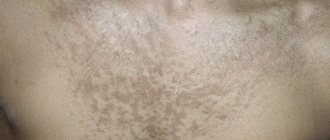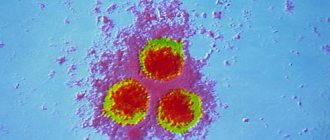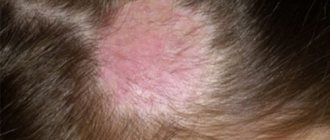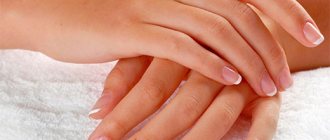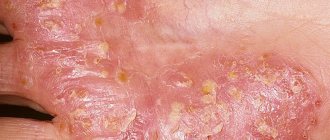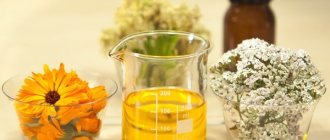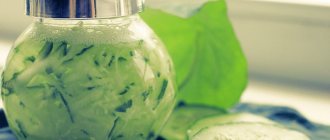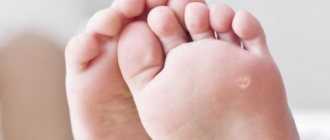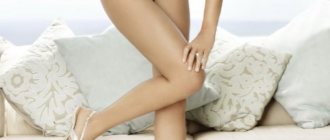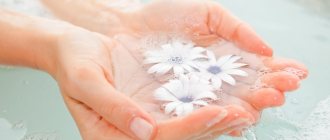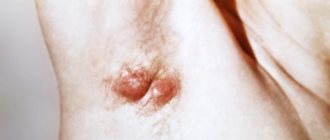Just the mere mention of the skin disease, popularly known as “ringworm,” will make you shiver involuntarily. It probably wouldn’t even occur to you that a baby stroller left on the staircase could cause infection in a newborn. But this is, indeed, so. It’s just that a homeless sick kitten also wants to relax in a cozy and warm place.
Ringworm is a contagious skin disease caused by dermatophyte fungi (literally, growing on the skin) of two types: trichophytosis or microsporum.
It should be immediately noted that modern doctors practically do not use the term “ringworm”, because This is more of a general concept than a specific diagnosis. It is more correct to call this pathology trichophytosis and microsporia (depending on the type of pathogen). The external manifestations of these diseases are largely similar.
Microsporia and trichophytosis are widespread, and children are especially susceptible to infection.
What is lichen
The term lichen in a child is understood as a collective concept meaning a fungal and viral disease.
The classification includes several types of pathology, differing in course, causes and external manifestations. Ringworm on the skin of a child occurs more often under the age of 14 years. When the first unusual rash appears, parents should contact a dermatologist, infectious disease specialist, or pediatrician as soon as possible. This is due to the high degree of contagiousness of the disease. For this reason, sick children pose a great threat to the people with whom they come in contact.
Viral and fungal lichen requires timely initiation of treatment. Advanced forms are difficult to treat, and it takes a lot of time. Depending on the type, ringworm may resolve on its own. Some variants of the disease return again with the same symptoms, while others become chronic.
The incidence rate increases significantly in the summer and autumn seasons. During this period, specific signs appear and treatment of lichen must be comprehensive in order to eliminate the manifestations in a short time.
The most favorable period for the development of the disease, according to Dr. Komarovsky, is a warm time, when optimal conditions are created for the reproduction and spread of infection. Heat, moisture in the environment, and increased sweating help increase the permeability of the skin. This makes it easier for the infection to break through the protective barrier. Symptoms of lichen in newborns and older children appear when the body's defenses against pathogenic microorganisms are insufficient.
General information
Ringworm in children is a collective term denoting viral and fungal skin diseases in children, varying in etiology, external manifestations and course. According to statistics, up to 90% of children attending various children's institutions are affected by one type or another of lichen. In pediatric dermatology, lichen is most often diagnosed in children under the age of 14 years. Due to the fact that some types of lichen are highly contagious and pose a danger to surrounding children and adults, in case of any skin changes, it is necessary to show the child to a pediatrician, pediatric dermatologist or infectious disease specialist.
Specialists in the field of pediatrics most often have to deal with cases of ringworm (trichophytia and microsporia), pityriasis versicolor (multi-colored), pink (Zhiber's zoster), and less often - red flat and herpes zoster in children.
Ringworm in children
Preventive measures
Table - Degree of infectivity of different types of lichen
| Type of lichen | Path of infection | Contagiousness degree |
| Shearer | contact | The tallest |
| Pink | contact | Low (there is an opinion that it is not contagious at all) |
| girdling | contact | High (in the phase of active rashes) |
| Color | contact | Low (there is an opinion that it is not contagious at all) |
Prevention is most important for ringworm, which is usually transmitted by contact. What to do if lichen is found in a child or adult family members?
- The lichen spots should be covered so that the scales do not spread throughout the house: a scarf on the head, clothes covering the arms and legs.
- Wet cleaning should be carried out every day using disinfectants.
- It is necessary to boil underwear, bed linen, and towels.
- It is better to throw away the old washcloth.
- Disinfect combs and hair accessories and replace them with new ones after treatment.
- Clean clothes and bedding should be ironed thoroughly on both sides.
It is important to know: if you have ringworm, you are prohibited from visiting children's groups. Visits are permitted only after triple confirmation of a negative test result.
There is a separate issue about pets. It is necessary to exclude that the source of infection is a cat or dog. To do this, the animal must be taken to a veterinary hospital and examined. To prevent ringworm, children should be taught not to pet stray cats and dogs on the street.
Treatment of deprivation in children is carried out over a long course at home. If the fungal nature of the disease is established, the most effective remedies will be antifungal drugs. Ringworm is the most common disease among children. You can’t start it, because lichen can become chronic, and the child will always be infectious to others.
Author: Alexey Shevchenko August 18, 2020 23:10 Category: Nature and people
Good day, dear regular readers and guests of Alexey Shevchenko’s blog “Healthy Lifestyle”. The health of children always causes concern for caring parents. It is very difficult to protect a child from all kinds of infections: after all, you cannot isolate a little person from the outside world and put him under a sterile cap.
Running barefoot on the grass, building sand towers on the beach, playing with yard dogs and cats is an integral part of childhood. But it is all this that creates the strongest threat of getting one of the most unpleasant diseases - lichen. Therefore, all parents need to know how to treat lichen in a child and immediately consult a doctor at the first sign.
Symptoms of ringworm in children
How to understand that the lichen is going away? A sign of recovery is the convergence of the blisters and the gradual falling off of the crusts. The border becomes lighter, its surface is smoothed and evened out compared to the surrounding skin.
First, a light pink, smooth spot forms at the site of the lichen; later the skin acquires a normal shade. If trichophytosis occurs in a purulent form, scars may remain on the surface of the dermis. The bald patches on the scalp gradually grow back, and permanent baldness is rarely observed.
The child must be registered with the attending physician for another 3 months and periodically undergo tests for fungal flora.
Every parent should remember that children more often get ringworm due to undeveloped immunity. The fungus can affect both the scalp and smooth dermis.
Important! Strengthening the immune system by hardening and a healthy lifestyle, good nutrition of the child is the key not only to health, but also to the absence of such a problem as ringworm.
The main symptoms of the pathology are:
- The lesion on the body itself, the scalp at the very beginning, resembles a clearly defined spot, light pink or reddish in color.
- Hair becomes sticky and dull, and often splits. The spot on the head will increase in size, its middle will begin to peel off and become crusty.
- If the fungus infects smooth skin, the lichen takes the form of a light spot with a border; as it develops, it takes the form of a plaque with characteristic nodules.
- Ringworm in a child can provoke migraine attacks and fever, loss of appetite and becoming restless.
- If a secondary infection is added to the lichen, an inflammatory process develops; in addition to the skin, the nail plate can also be affected; it breaks and peels off easily.
Important! The disease itself can occur in a latent form - in this case, the child will infect the people around him.
The ringworm type is provoked by a fungus classified as Trichophyton and Microsporum, and taking into account the source of infection, doctors talk about the following forms:
- Anthroponotic form - in this case, the route of infection is from an infected person to a healthy person, although ringworm in children is transmitted through household items, hygiene items, and through tactile contact with an infected person.
- The zoonotic variety is somewhat more common - in this case, the source of infection will be both domestic and wild animals, objects with which carriers of the fungus have come into contact, through sand, and so on.
Among other things, doctors divide the following types - superficial, mild type, chronic form of the course, as well as infiltrative-suppurative.
Each of the described forms has a certain incubation, latent period - for example, the mildest, superficial type occurs in a latent form from 5 to 7 days, while at the same time, the infiltrative-suppurative form may not manifest itself with negative symptoms.
Worth remembering! The source of infection, as we see, can be both an animal and a person.
The entire course of treatment at the very beginning requires compliance with a number of simple and effective rules that will enhance the positive effect of the main course. What should parents do when they find out that their child has lichen:
- Avoid taking a bath to avoid pathological processes deep into the skin - a maximum of a shower, after which you should let the skin dry naturally, without rubbing with a towel.
- The child should have separate hygiene items, bed linen, and the clothes themselves should be made from natural fabrics.
- You should not allow your baby to be in direct sunlight for a long time, exclude any stressful situation and prevent hypothermia and overheating.
- It is worth balancing your diet - maximum vitamins and minimum unhealthy, spicy, salty, fatty foods.
Treatment of ringworm involves the use of external preparations - antifungal compositions of medicinal ointments containing sulfur, as well as its enriched salicylic composition, alcohol tincture of iodine solution. In terms of time, the course of treatment takes 5-7 weeks, when external antifungal agents are supplemented with physiotherapeutic procedures - UHF and UV irradiation, a course of microwave therapy and the use of electrophoresis. Next, we will consider these tools in more detail.
Important! The presented rules are simple and effective, which are not difficult to follow, but by following them you will protect your baby from the possibility of contracting lichen.
How to treat ringworm in a child? First of all, ointments and these include the following drugs:
- High effectiveness of treatment is shown by sulfur and sulfur-salicylic ointments, or ointments that combine sulfur and tar - they are often prepared in pharmacies according to a prescription prescribed by a dermatologist. For superficial ringworm, Lamizin ointment helps perfectly; for deeper damage to a child’s skin, Triderm or Dimesxidine.
- An equally popular remedy in the treatment of ringworm is ointments that contain hormones - the main thing to remember is that they should only be used in the fight against pathology for a short period of time.
Ointments are used according to the regimen prescribed by the doctor - but most often it is enough to treat the lichen 3-5 times a day. But if the lesions are large in area, it is supplemented with antibiotics.
Worth remembering! Do not self-medicate - the drug and treatment regimen should only be prescribed by a doctor.
Ringworm in a child on the head and throughout the body can be treated not only with means from the arsenal of traditional medicine, but also supplemented with means from the arsenal of traditional medicine. Such remedies are especially relevant for young children, when medications can trigger allergies.
Propolis tincture - you can buy it at the pharmacy or prepare it yourself. 200 ml is enough. alcohol dissolve 50 g. propolis, leave for a week in a dark place.
After this tincture, treat the affected area of the child’s skin 2-3 times a day.
The following recipe will help in the fight against ringworm - mix citric acid and vegetable oil, such as olive, in proportions of 1 to 3 and treat the affected area with this mixture for 2-3 weeks.
It is best for young children to practice treatment using this mixture. Mix salt and baking soda in equal parts, add a little water until the consistency of thick sour cream is obtained. It is applied to the area of ringworm 3-5 times a day. When the lesion has a small area, it is optimal to treat ringworm with a solution of alcohol tincture of iodine.
Parents, remember! Folk remedies are simple, effective, but cannot always overcome lichen and therefore it is recommended to use them as an addition to traditional medications prescribed by a doctor.
If ringworm is diagnosed in an infant, special care should be taken so as not to harm the baby’s delicate skin, thereby aggravating the course of the pathology.
Most often, lesions are treated with medicinal compositions in the format of talkers or ointments based on sulfur, as well as tar or iodine.
In addition to medicinal, ready-made compounds and preparations, take into account the means from the arsenal of traditional medicine.
Dry powder of ordinary mustard should be diluted to the consistency of thick cream with apple cider vinegar and table vinegar and this mixture is applied to the area of the body affected by ringworm. It is not washed off, but left until completely dry - when it crumbles, the procedure for applying the composition is repeated again. But no more than 3 times a day.
A simple and effective method that will not harm the baby - fresh cabbage leaves are simply ground in a blender until mushy, mixed in equal proportions with sour cream and this mixture is applied to the affected area of the skin. Efficiency is achieved due to lactic acid contained in sour cream and cabbage juice, which, among other things, softens the skin.
A decoction made from beet roots with the addition of honey is a safe and effective remedy.
Treatment of ringworm in children involves preparing the following recipe: the beets are peeled and boiled for 15 minutes, then honey is added to the resulting decoction at the rate of 1 tbsp per glass of liquid. l. sweet bee product. This solution is used to treat the affected areas of the body.
Among other things, you can fight lichen in a small child with the help of a decoction obtained after boiling buckwheat without salt. They simply wipe the affected areas of ringworm with it - the product is natural and does not cause allergies in the baby.
To prevent infection of healthy family members and people around the baby, you should follow the following rules. So, during treatment, the baby’s clothes and underwear should be personal - they should be washed at high temperatures, ironed, and household items such as a comb, dishes, etc. should be treated with disinfectant compounds.
Also, you should not bathe an infected baby with healthy children and adults, and after taking water procedures, treat the bath with disinfectant. It is advisable to isolate the child from healthy people for the period of treatment - it is advisable not to let him into kindergarten or school.
You can return to your usual way of life and communication only when the affected areas on the body do not appear under the special glow of a Wood’s lamp. If laboratory tests for fungus are negative, taken at intervals of 3-5 days.
Remember! The simple rules are simple, but in their action they allow not only to counter the risk of infection and, even if ringworm is diagnosed, to speed up the recovery process.
In his scientific works, Dr. Komarovsky often raises the topic of treatment, as well as effective prevention of fungal diseases in children. The main thing that parents themselves should remember when it comes to fighting ringworm is that it is important not to self-medicate. It is necessary to consult a doctor and begin treatment prescribed by a specialist.
First of all, it is worth talking with the child himself about the danger of such a disease as ringworm - tell him that this is a dangerous disease, not a cosmetic defect, but also a dangerous disease that affects internal organs. Explain to your child that you should not pet a street puppy or kitten, and that your pets should be regularly vaccinated and treated for parasites.
Treatment methods at home
Our service will select the best dermatologist for you for free when you call our Unified Appointment Center by phone. We will find an experienced doctor near you, and the price will be lower than if you contact the clinic directly.
Timely therapy greatly facilitates the treatment of lichen in children. The treatment complex consists of quarantine, physiotherapy and treatment with medications. You cannot do without mandatory daily cleaning of the house, because the fungus can be infected through spores. Bed and underwear should be changed and ironed frequently. The child should be treated from a couple of weeks to a couple of months.
Let's pay attention to the best home treatment methods for depriving children:
- Application of ointments. The use of riodoxol, salicylic, zinc, florenal or sulfur-tar ointments will effectively cure lichen. However, it is worth checking the child’s body for allergies by applying the product to a small area of the body. If after two hours nothing has happened, then you can use it without fear. The affected skin is treated with ointment twice a day. This may cause some redness and burning, which is completely normal. The most common ointments: naftifine, isoconazole, bifonazole and others.
- Let's take a closer look at zinc ointment. The product is very effective against eczema, pink or ringworm. The ointment is applied to the affected area until the symptoms of the disease disappear (up to 6 times a day). The medicine perfectly relieves superficial lesions at the initial stage of the disease. Experts value zinc ointment for its healing properties: anti-inflammatory effect and gradual restoration of the skin. And it also doesn't dry out the skin.
- Treatment with tablets. The dose of medication for children should be less than for adults. And with lichen in infants, it is better not to self-treat; leave this matter to the doctors. Ringworm and pityriasis versicolor are treated with antimycotic tablets Orungal, Lamisil and Mycozoral. Lichen planus and rosacea can be cured with antihistamines: Suprastin, Claritin and Cetrin. Herpes zoster will require antiviral drugs, for example, Acyclovir is suitable.
- Anti-lichen cream. Remember that the cream should be chosen depending on the age of the baby. The use of Clotrimazole antifungal cream is permitted for children at least three years of age. After reaching the 12-year threshold, the use of creams such as Lamisil or Miconazole is recommended.
- You should not ignore folk remedies. Using birch tar, raisins, garlic, birch charcoal or propolis you can achieve impressive results. For example, you can gently rub the affected area of the body with washed, pitted raisins.
Ringworm in a child: what does it look like, how to treat it and how to protect yourself?
Taking into account the pathogens that cause them, lichens in children are divided into fungal and viral. Infection of children with lichen usually occurs in groups (kindergarten, school, camp), public places (swimming pools, baths, hairdressers), through close contact with animals (dogs, cats), and failure to comply with personal hygiene rules.
Ringworm in children has two types: microsporia and trichophytosis. The first of them is caused by the parasitic fungi Microsporum canis; the second is Trichophyton tonsurans. The main carriers of the threat of ringworm infection for children are animals and people suffering from fungal infection. In some cases, the disease is transmitted through household items and personal items containing fungal spores (toys, washcloths, combs, hats).
Pityriasis versicolor or versicolor in children refers to skin mycoses caused by three types of yeast-like fungus - Pityrosporum orbiculare, P. Ovale or Malassezia furfur. This fungus often lives on the skin without causing pathological changes. The impetus for the fungal process can be infectious diseases (tuberculosis, AIDS), hormonal disorders (diabetes mellitus, colloid goiter, obesity, Cushing's disease), hyperhidrosis, seborrhea, rheumatism, lymphogranulomatosis, leukemia, hereditary predisposition. Lichen versicolor is less contagious and is more common in children during adolescence. The favorite habitats of pathogenic fungi are areas of the skin with a large accumulation of sweat glands.
Pityriasis rosea in children usually occurs after respiratory and intestinal infections, vaccinations, and acute febrile conditions. The causes of the disease are not precisely known; The causative agent is presumably human herpes virus type 7 (HHV7), and the infection is transmitted by airborne droplets or contact. Pityriasis rosea affects children and adults aged 10 to 35 years.
The etiology of lichen planus is also not well understood. Currently, a number of theories are being considered (hereditary, viral, immunoallergic, neurogenic, intoxication).
Shingles in children is better known as herpes zoster. The disease is caused by the herpes virus Varicella zoster, which is also the causative agent of chickenpox. After chickenpox, the virus “dormants” in the nerve ganglia and is activated under the influence of unfavorable factors. Seronegative children exposed to someone with shingles may develop chickenpox.
The highest incidence of lichen fungus among children is observed in the warm season; viral - in cold seasons. The occurrence of lichen in children is predisposed by weakened immunity, lack of vitamins, and overwork; the presence of ARVI, allergic reactions, vegetative neuroses, excessive sweating, minor skin damage.
Ringworm in children
Ringworm is the most common fungal disease among children, affecting the skin, hair, and nails.
From the moment of infection with the fungus to the appearance of symptoms of lichen in children, it can take from 5 days to 6 weeks. When the skin is affected, delimited round and oval spots of a reddish color are formed. The skin in these areas is covered with crusts and scales, and is very flaky; sometimes there is itching and burning. If ringworm in children affects the scalp, this is accompanied by the formation of a large rounded area of baldness, within which the hair is broken off (as if cut) at a level of 4-8 mm from the scalp. Around the main focus there may be small, sometimes numerous similar lesions.
In weakened children, ringworm can occur with lymphadenitis, fever, loss of appetite, headache, pyoderma, folliculitis and perifolliculitis of the head.
Pityriasis versicolor (varicolored) in children
The favorite localization of pityriasis versicolor in children is the “seborrheic zones” - the scalp and the upper half of the body. At the onset of the disease, yellowish dots appear around the mouths of the hair follicles, which then transform into a pink-yellow (brown-yellow) spot covered with pityriasis-like scales. The elements gradually grow along the periphery, merging into larger foci. When the scales are scraped, noticeable peeling occurs.
The color of the affected areas can vary from light cream to dark brown, which gave rise to the double name of lichen in children - pityriasis versicolor or multicolored. Areas affected by lichen tend not to darken from tanning, which explains the appearance of hypopigmented areas on the skin of children.
Seborrheic or atopic dermatitis in children, associated with the causative agent of lichen – P. orbiculare (ovale), is a risk factor for the formation of complicated forms that are resistant to traditional therapy.
Pityriasis rosea in children
In the typical form of pityriasis rosea, a primary lesion first forms on the child’s body - a single maternal plaque. It looks like a bright pink oval spot ranging in size from 2 to 5 cm in diameter. After about 7–10 days, multiple secondary rashes appear, smaller in size (1-2 cm), oval in shape. The rash is characterized by the presence of peeling in the center of the spot and a red border, free of scales, along the periphery, which is why they resemble a medallion. As a rule, spots are located in natural folds of the skin (along Langer's lines).
When affected by pityriasis rosea, children may experience slight itching. The period of rash lasts 4-6 weeks, then the elements disappear on their own without a trace. With constant irritation of the affected areas of the skin (washing, rubbing against clothing, ultraviolet irradiation), the rashes can become infected, leading to purulent complications - folliculitis, impetigo, hidradenitis.
Lichen planus in children
This type of lichen in children is extremely rare. The disease affects the skin, mucous membranes, and rarely the nails. Dermatosis is characterized by a monomorphic rash in the form of flat nodules of bright red or bluish color with a shiny surface, 2–3 mm in diameter. Lichen planus is accompanied by intense itching, depriving children of sleep. Merging, the nodules form small plaques with small scales on their surface.
Typical localization of rashes with lichen planus in children is the flexor surfaces of the forearms, wrist joints, inner thighs, inguinal and axillary areas, and mucous membranes of the mouth.
Shingles in children
Shingles (herpes) develops in children over 10 years of age and adults who have had chickenpox in the past. The appearance of skin rashes with shingles in children is preceded by a flu-like condition - malaise, chills, fever, burning sensation, numbness or tingling along the sensory nerves, in the area of future rashes.
After 1-2 days, groups of 0.3-0.5 cm vesicles filled with transparent contents appear on an erythematous-edematous background. The rash is located linearly, along large nerve trunks and nerve branches. During the period of active rashes, high fever, radiating pain along the intercostal and trigeminal nerves, and lymphadenitis are noted. After a few days, the contents of the bubbles become cloudy and dry out; In their place, crusts form, which then fall off, leaving behind light pigmentation. Recovery usually occurs within 15 days to 1 month.
With herpes zoster, children may develop stomatitis, conjunctivitis, keratitis, iridocyclitis, optic and oculomotor neuritis, and neuralgia. In weakened children, herpes zoster can be complicated by serous meningitis, encephalitis, and myelitis.
Diagnosis of lichen in children, as well as determination of its form, is carried out by a pediatric dermatologist, mycologist or infectious disease specialist. To confirm the expected diagnosis, the doctor conducts a visual examination of the skin, special tests, and fluorescent diagnostics. Each form of lichen in children has its own characteristics of the morphology of the elements, as well as the characteristic fluorescence of the affected areas when examining the child’s skin under a Wood’s lamp.
To determine the species of fungal pathogens, a skin scraping is examined under a light microscope and the scraping/secret is cultured for microflora. In order to confirm the diagnosis of lichen planus in children, it is sometimes necessary to resort to a skin biopsy and study of the morphology of cells and tissues.
For shingles in children, blood ELISA may be required, consultations with a pediatric neurologist and a pediatric ophthalmologist.
Differential diagnosis of lichen in children is carried out with psoriasis, eczema, local allergic reactions, childhood infections (measles, rubella), vitiligo, alopecia areata in children (with ringworm).
The treatment regimen for lichen in children depends on the type of infection and the severity of the manifestations. In all cases, treatment should be carried out under the supervision of a dermatologist. Contagious forms of lichen require isolation of the sick child and temporary cessation of contact with other children.
Treatment of lichen in children caused by fungal pathogens involves shaving the hair in the affected area, taking systemic antimycotics (griseofulvin), treating the skin with antifungal ointments, carrying out restorative vitamin therapy, and immunomodulatory therapy. For severe itching of the skin, antihistamines and corticosteroid ointments are prescribed. In case of damage to the flexible scalp, medicated fungicidal shampoos are used. The criterion for cure for fungal lichens in children is a three-fold negative test for fungi.
Treatment of herpes zoster in children is carried out with local and general antiviral drugs (interferon, acyclovir), analgesics, and NSAIDs. The areas of rash are lubricated with brilliant green and other disinfectant solutions to prevent suppurative complications. Physiotherapeutic procedures are very effective for herpes zoster in children - solux, ultraviolet irradiation, ultrasound therapy, electrophoresis, diathermy, magnetic field. In cases of severe pain, novocaine blockades and reflexology are performed.
An important point is strict adherence to hygiene rules (regular change of the child’s linen and clothing, washing and ironing them; avoidance of scratching; disinfection of personal hygiene items), temporary exclusion of general water procedures, hypoallergenic nutrition.
Factors to prevent lichen infection are: complete isolation of the sick child from healthy children; limiting contacts of children with stray animals; Regular examination of pets by a veterinarian. It is extremely important to pay attention to strengthening children’s immunity and instilling hygiene skills in children.
Treatment of lichen in children is a long and patient process. Often, the disappearance of visible manifestations does not mean complete recovery, therefore it is necessary to strictly adhere to the terms of therapy and quarantine indicated by the doctor.
- Preparations for local application.
- Forms for oral administration.
- Supportive therapy.
- Traditional medicine.
What is lichen?
Prevention
To eliminate the possibility of your baby becoming infected with lichen, a program of preventive measures should be aimed at strengthening the immune system and promoting hygiene habits. Hardening or vitamin therapy prescribed by the attending physician can protect children from viral diseases. Parents should teach their son or daughter to constantly wash their hands before eating, after walking or touching animals. Checking your pets for health problems will once again protect your family from this type of disease. An effective method of prevention is cleaning the apartment using disinfectants.
Treatment of pityriasis rosea
The initial stage involves the presence of red spots on the skin of the abdomen and limbs. Their shape is most often oval. The first elements are called maternal plaques. In rare cases, parents note a deterioration in general health before the appearance of rashes. After 1-2 days, the red areas begin to peel off. Then, after a few more days, lichen appears on the body, face, and chest. New areas affected by the fungus appear smaller.
Most often, elements appear in skin folds, which is considered their most common location. As scales form, the center of the spots becomes yellow, and the edges acquire a red tint. Due to this type of elements, they are called medallions.
In some cases, instead of a red spot, blisters form on the neck or other part of the body. Full recovery occurs after 2 months. The disease is transmitted by contact from a cat to a person or spreads between people. For this reason, isolation of patients is required for the entire period of illness.
- Antihistamines (“Suprastin”).
- Antibiotics (“Erythromycin”).
- Systemic interferons (“Ridostin”).
- Systemic glucocorticoids (“Prednisolone”).
Ointment for pityriasis rosea is used only after a doctor's prescription. When the first rash appears, it is not recommended to start treating the child on your own. Zinc ointment is prescribed for treating stains and Vishnevsky ointment and water-zinc mash. Antihistamines must be used. Calcium gluconate is used in 3-5 injections.
The duration of therapy depends on the severity. The effectiveness of a remedy for lichen is judged by the positive dynamics of the condition and the reverse development of the rash. Physiotherapy is used. PUVA therapy is aimed at slowing down the proliferation of cells in the spots. Ringworm in an infant is treated in this way for no more than 10 sessions.
If a child has tinea versicolor, topical corticosteroids are included in the regimen. Such patients must be given an individual dose of antihistamines. This is due to a possible allergic reaction to hormones. Lichen can be treated with retinol-based medications, which eliminate the itching sensation.
How long does it take for pityriasis rosea to heal in humans? The disease is characterized by seasonal exacerbations that occur in the autumn-spring period. The rash and spots on the body appear within 10 days and do not cause discomfort or itching. The pathology is completely cured in 1–2 months, but with a chronic course, relapses periodically occur.
Pityriasis rosea does not go away for a long time if the immune system is severely weakened, with increased sweating, and frequent skin contact with water. The disease does not require special treatment, the spots disappear on their own. The use of anti-inflammatory, drying ointments, and antihistamines speeds up recovery.
How do you know that pityriasis rosea is starting to go away and is no longer contagious? New spots stop appearing on the body, old ones dry out, become lighter, and the surface is cleared of scales. The cushion is smoothed and compared to healthy dermis. Patients are advised to be tested for the presence of fungi in the scraping taken to ensure complete recovery. If, according to the results of 3 studies, no pathogenic microorganisms were identified, remission is diagnosed.
Duration of therapy for trichophytosis
One of the most common types of lichen is ringworm, caused by protozoan fungi of the genus Microsporum. Pathogenic microorganisms affect the skin, hair, and in rare cases, nail plates and eyelashes. They are most often localized in open areas of the body and scalp.
Ringworm in humans forms after contact with infected people; children transmit the infection during joint games, through shared toys. The likelihood of developing trichophytosis increases if there are fresh abrasions or scratches on the skin. Pets, stray cats, and especially small kittens are also sources of infection.
The incubation period lasts from 5–7 days to 2 months. Depending on the type of ringworm, the symptoms may be mild or cause severe inflammation. In children, the predominantly erymatous-edematous form of the disease is diagnosed. Fungal infection of the skin provokes the development of an allergic reaction.
Red, swollen spots with a slightly flaky surface form on the body or head, the lesions itch, which often leads to scratching of the wounds and the introduction of a secondary infection. Bacteria increase inflammation, provoke suppuration, and the formation of weeping ulcers. Hair falls out in the affected area, leaving round bald spots.
Kids become restless, capricious, sleep and eat poorly. Body temperature may rise, regional lymph nodes may become denser.
If necrotic tissue damage occurs, the patient must be hospitalized and treated in a hospital setting.
How long does it take to treat ringworm in a child, and can complications occur? How quickly the dermis clears depends on compliance with the doctor’s recommendations, the age of the baby, the severity of the pathology and the presence of concomitant diseases. For mild cases, local treatment with ointments and shampoos is carried out for up to 14 days.
How long does it take for shingles to go away in children?
- frequently ill children;
- newborns;
- with oncology;
- in the presence of chronic diseases;
As soon as the immune defense becomes insufficient, the herpes virus, which is in a dormant state, begins to actively manifest itself.
Symptoms
It is not immediately possible to recognize herpes zoster in children. Elements often appear on the leg and torso. The following signs are characteristic:
- Increase in body temperature.
- Chills.
- Enlarged lymph nodes.
- Burning, stinging or itching in the areas where the rash appears.
- Decreased appetite.
At the beginning of its development, the first signs in the form of ARVI may appear. After 1-2 days of development of nonspecific symptoms, lichen colds begin to actively manifest themselves. Pink bubbles appear along the nerves (intercostal spaces are a common location for rashes). Gradually they merge. After a week, the elements dry out and the surface becomes covered with crusts.
Knowing everything about lichen, parents should exclude the possibility of scratching the elements on the child’s skin. At an older age, he needs to explain this. The presence of an open wound in an infant when scratching will lead to a secondary infection. Against the background of reduced immunity, it will begin to actively multiply, which will result in the addition of concomitant pathology.
During the treatment of shingles, antiseptics are used as needed. The effective anti-inflammatory ointment “Sanaflan” will help you cope with itching. It is important to remember that washing with shingles is not recommended, but depending on the severity of the condition, the attending physician may recommend hygiene procedures.
How long does it take for herpetic rash to heal in young children? Before the lesions appear, the child’s health deteriorates, he or she feels chills, his body temperature rises, and he is bothered by itchy skin. After 3-4 days, small blisters filled with liquid appear. After a few more days, the papules open and form yellowish crusts.
How quickly the rash heals depends on antiviral treatment and the state of the immune system. After cleansing the skin, neuralgic pain may persist for a long time; therapy in such patients takes about 1 year.
Ringworm
- hereditary predisposition;
- drug intoxication;
- autoimmune factors;
- allergic lichen;
- neurogenic form;
- viral infection.
There are several forms along the way - acute, subacute and chronic.
Symptoms
The onset of the disease occurs differently in each child. Lichen planus appears after 7-10 days against a background of general malaise, weakness and loss of appetite in the form of a rash. For other patients, this form of development of the disease is not typical and they develop specific elements without affecting their well-being.
- underbelly;
- on the fingers;
- in the lumbar region;
- on the butt;
- elbow bends;
- on the feet;
- axillary fossae.
Ringworm most often does not appear on the head, which becomes one of the main distinguishing features. The rash consists of papules that do not have a cavity inside. They have an umbilical depression in the center of their elements and a polygonal shape.
This form of skin disease in children is quite rare and can be triggered by an allergic reaction, psycho-emotional shock, or taking certain medications. Lichen planus is not an infectious disease and therefore cannot be transmitted to another person through close contact.
The rashes are localized on the skin of the extremities, most often in the joint area, and also form on the mucous membranes of the oral cavity. Externally they look like compacted bright red nodules that cause severe itching.
What to do when lichen planus appears and how to treat it so that the spots go away faster? Therapy is carried out with ointments with glucocorticoids, and physiotherapeutic procedures accelerate recovery. Since the disease has a relapsing course, the rash persists from 6 months to 1 year, new spots can form in place of newly healed ones. The longest treatment times are observed in the presence of lesions in the oral cavity.
Types of lichen that people suffer from
In children and adults, lichen develops quite quickly; the causative agents of the disease are fungi, infections and viruses. Let us consider the main types of contagious lichen:
- Shingles, which affects the area under the ribs, arms, and other areas of the skin. Initially, the skin begins to itch, after a few days it becomes covered with rashes - these are transparent blisters filled with liquid. The rashes burst, releasing liquid, a crust forms in their place, the disease is accompanied by pain, and its course vaguely resembles chickenpox. This type of lichen is caused by a herpetic infection; if a person has had chickenpox, then the risk of infection is minimal.
Non-contagious types of lichen traditionally include pityriasis (colored) lichen, in which numerous pale spots appear on the skin, psoriasis, which is a chronic disease, and weeping lichen.
It is worth mentioning lichen planus, which is characterized by the formation of small nodules and spots on the skin. This type of disease is of allergic origin and can develop against a background of stress.
It is believed that pityriasis rosea, accompanied by the appearance of spots of different diameters, with a scaly center and smooth edges, is contagious, but this judgment is erroneous. Most often it spreads to the upper part of the body (stomach, shoulders, sides), accompanied by itching. The spots, spreading across the skin, merge with each other.
Symptoms with photos
The first sign of lichen is multi-colored spots that appear on certain parts of the body. The spots can have a smooth, rough, scaly surface; they are often very itchy and wet; the latter symptom indicates the development of eczema or shingles.
